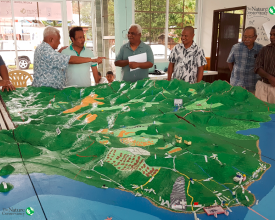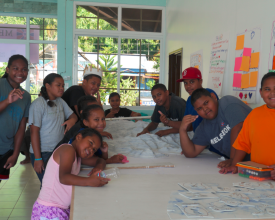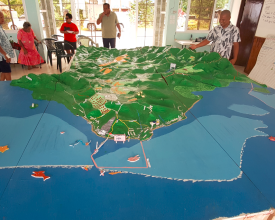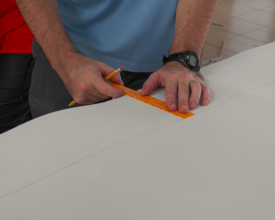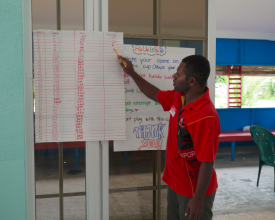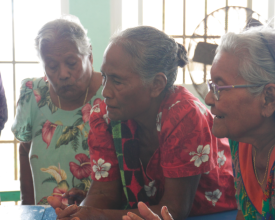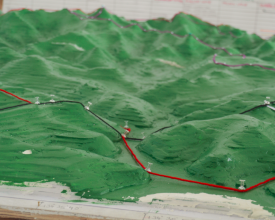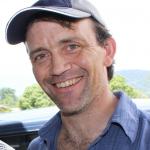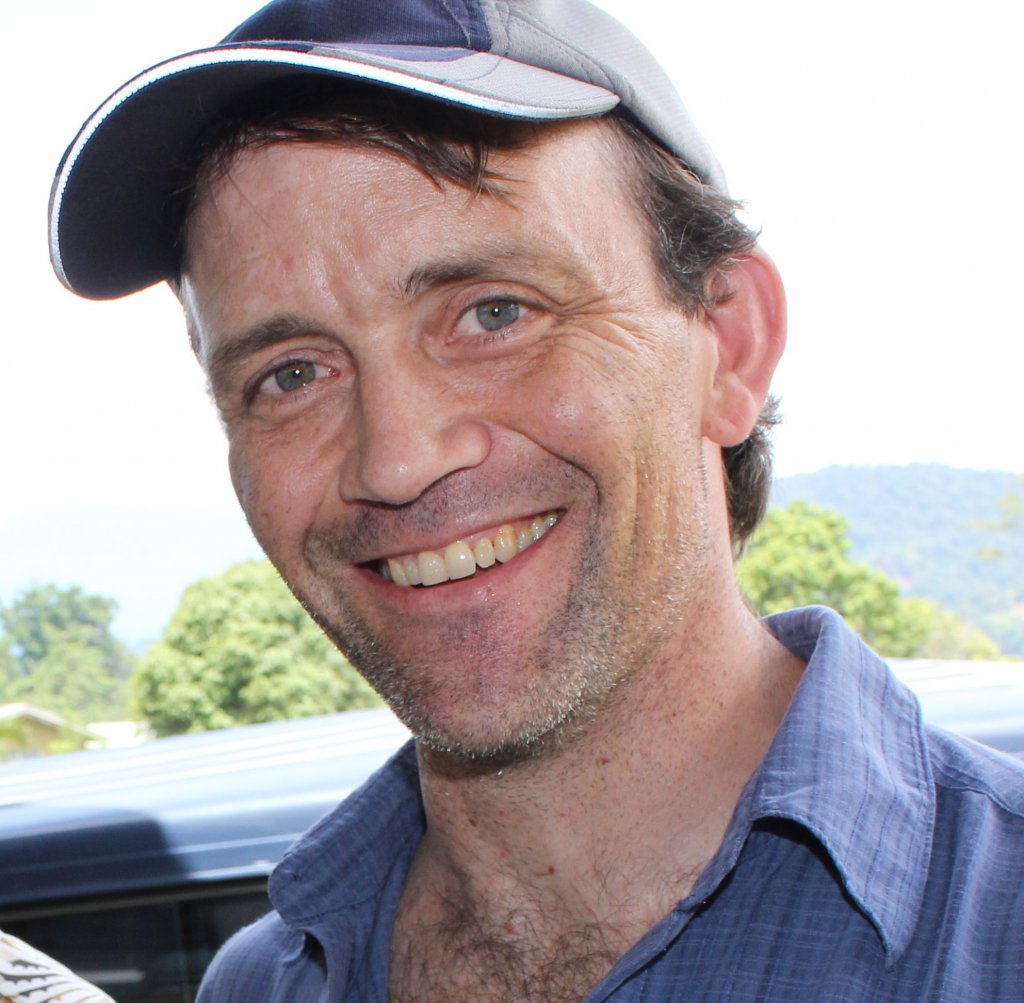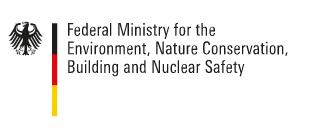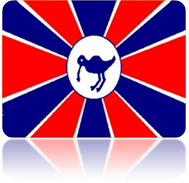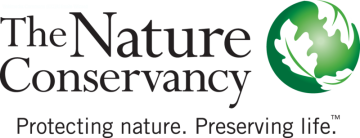
Cartographie 3D participative pour l'aménagement du territoire et l'adaptation au changement climatique
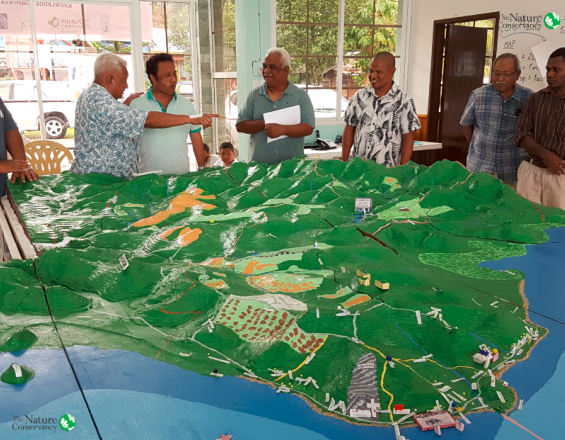
En raison de la pression croissante exercée sur les ressources naturelles vulnérables par le tourisme, le développement local et le changement climatique, les planificateurs du gouvernement de l'État de Melekeok (Palau) ont identifié le besoin de donner la priorité à la planification de l'utilisation des terres. Un modèle 3D de l'État a été créé à l'aide d'un processus participatif, utilisant les connaissances de tous les secteurs démographiques de la communauté. Le résultat final est un modèle de 12 pieds x 10,5 pieds x 6 pouces qui sert d'outil pour guider les décideurs et les membres de la communauté dans la planification de l'adaptation au changement climatique, la gestion des ressources naturelles et la résolution des problèmes de zonage.
Contexte
Défis à relever
En tant qu'île isolée du Pacifique occidental, les Palaos dépendent d'un environnement sain pour les services écosystémiques qu'il fournit. Les ressources en eau douce, des stocks de poissons sains et des côtes stables sont tous essentiels au bien-être de ses habitants, en particulier dans l'État de Melekeok.
Récemment, le tourisme envahissant et le développement qui lui est associé, ainsi que les impacts géophysiques le long du littoral, probablement dus au changement climatique, ont menacé la qualité et la quantité des ressources naturelles de Melekeok dont ses habitants sont si dépendants.
Un défi particulier pour le Melekeok est d'équilibrer la croissance économique avec une gestion avisée des ressources naturelles et des zones protégées, ainsi qu'avec le maintien de leur patrimoine culturel.
Emplacement
Traiter
Résumé du processus
Cet atelier est avant tout une expérience d'apprentissage, avec un produit/outil tangible comme sous-produit. En tant que tel, l'atelier doit faire l'objet d'une approche équilibrée reposant sur une planification et une exécution techniques solides, une communication approfondie, une libre circulation de l'information et un échange de connaissances, ainsi qu'un enthousiasme au niveau de la communauté pour garantir la valeur pratique de l'outil.
Les experts techniques doivent soutenir la communauté tout au long du processus afin que l'appropriation du modèle prenne racine. Ils planifient à l'avance et communiquent toutes les informations techniques relatives aux SIG aux responsables de la mise en œuvre et aux planificateurs de l'atelier, qui bénéficieront également d'une certaine expérience/exposition aux SIG. Les planificateurs, en étant proactifs et minutieux, seront en mesure d'atteindre le plus grand nombre de participants possible à un stade précoce. Cela permettra de recueillir le plus grand nombre possible de connaissances traditionnelles. La coopération entre tous ces ensembles de compétences et de données démographiques est à l'origine d'une utilité durable. Il y a plus de chances que le projet prenne racine si une communauté diversifiée et abondante apporte son soutien.
Blocs de construction
SIG/Planification technique
Les aspects techniques du tableau/modèle doivent être soigneusement planifiés par un spécialiste SIG. Les éléments clés à prendre en compte sont : l'intention du modèle, les ressources naturelles et sociales vulnérables, l'élévation des terres, la superficie des terres, les caractéristiques marines et aquatiques, l'espace nécessaire pour accueillir le modèle et l'accès aux matériaux du modèle.
L'étendue spatiale et l'altitude de la terre informeront le spécialiste SIG de l'échelle à utiliser. L'échelle a une incidence sur le nombre de couches de mousse à utiliser et, en fin de compte, sur la quantité de mousse nécessaire pour créer le modèle. Une expérience des cartes topographiques et de l'analyse géospatiale est requise.
Facteurs favorables
- Le principal facteur favorable est l'expertise technique dans le domaine de la cartographie/du SIG.
- Si l'on travaille dans un endroit éloigné, l'accès au matériel modèle est essentiel et doit être organisé à l'avance.
- La capacité à communiquer des compétences géospatiales complexes dans le cadre d'exercices pratiques et créatifs est une autre compétence très utile.
Leçon apprise
- Les feuilles de mousse constituent une meilleure base que le carton.
- Les parties prenantes doivent fournir des informations techniques sur les considérations clés susmentionnées plusieurs mois avant l'achat des matériaux.
- Si l'altitude du terrain n'est pas très élevée, le changement d'échelle peut créer un modèle exagéré, ce qui est utile pour visualiser les propriétés du terrain et les problèmes potentiels.
Planification de l'atelier
L'atelier doit être soigneusement planifié longtemps à l'avance pour permettre à ceux qui ont un emploi, des obligations scolaires ou ménagères de répondre à leurs besoins prioritaires. Pour que cet atelier soit pleinement participatif, il faut qu'il y ait un coordinateur et que les tâches du personnel soient bien définies.
Facteurs favorables
- Un coordinateur de projet doté de bonnes compétences en matière de communication.
- Une bonne stratégie de sensibilisation pour faire connaître le projet à tous les participants potentiels et diffuser son objectif et sa fonction.
Leçon apprise
Un voyage de reconnaissance devrait avoir lieu au moins deux semaines à l'avance pour faciliter la préparation. Pendant cette période, les responsabilités doivent être déléguées afin que les participants arrivent à temps et soient prêts à travailler.
Échange de connaissances traditionnelles
Lorsqu'un atelier P3DM est organisé dans un endroit où la communauté autochtone est très présente (comme à Palau), l'utilité des connaissances traditionnelles est inestimable et irremplaçable. Le format d'un atelier P3DM peut aider à capturer les connaissances traditionnelles mieux que de nombreux exercices de planification, et peut assurer la préservation prolongée de ces connaissances en les stockant dans un modèle tangible.
Le P3DM capture les connaissances traditionnelles par le biais de discussions organisées et structurées autour du modèle. Il est important de planifier à l'avance la publicité de l'événement pour que le bouche-à-oreille atteigne les personnes vivant dans des communautés plus isolées. Des entretiens semi-structurés autour de la maquette permettent de saisir la plupart des idées ; il convient de prêter attention aux participants les plus silencieux, qui peuvent être réticents à l'idée de partager leur savoir dans la foule.
Facteurs favorables
Représentation de la communauté des personnes âgées ; forte demande pour la tenue d'un tel atelier (plus l'enthousiasme est grand, plus l'apport de connaissances est important) ; accès à la recherche des connaissances traditionnelles à l'avance par le biais d'une enquête ou d'une analyse documentaire ; diffusion précoce de la nouvelle de l'atelier par le bouche-à-oreille.
Leçon apprise
- Impliquer un processus au cours de l'atelier où les aînés interagissent directement avec la jeune génération afin qu'un tel échange d'apprentissage se produise directement et en temps réel.
- Les anciens possèdent généralement des connaissances plus traditionnelles et sont en mesure de fournir des informations spatiales importantes qui n'existent pas dans les plans d'occupation des sols modernes ; il est donc essentiel de les impliquer le plus possible. Il est essentiel de les impliquer le plus possible.
Garantir une utilité durable
Pour que le produit fini ait une valeur pratique, le modèle doit être i) hébergé dans un endroit pratique et propice à l'aménagement du territoire, ii) hébergé dans un endroit à l'abri des éléments environnementaux (pluie, vent, eau salée, etc.), iii) visible par les agences d'aménagement de la communauté/de l'État, iv) revu régulièrement pour incorporer les informations spatiales dans les exercices d'aménagement en cours.
Facteurs favorables
- Un espace d'accueil/une agence libre de tout élément environnemental
- Enthousiasme pour l'utilisation par les groupes de planification de l'État et de la communauté
Leçon apprise
Si une mallette peut être achetée/fournie, couvrir le modèle prolongera sa durée de vie de plusieurs années.
Impacts
Le modèle est actuellement installé dans un centre communautaire et sert d'outil visuel et de référence quotidienne aux membres de la communauté. Il sert d'outil éducatif pour les jeunes de la communauté, qui peuvent ainsi visualiser les ressources précieuses, les infrastructures, les habitats naturels et les points de repère de la communauté d'un point de vue géospatial.
De manière plus formelle, le modèle est utilisé par les planificateurs nationaux et nationaux lors de réunions et d'ateliers pour les guider dans leurs processus de zonage. Alors que le développement touristique cherche à s'étendre au-delà de Koror, des intérêts concurrents se disputent des terres précieuses dans l'État de Melekeok, et ce modèle offre une fenêtre précise et transparente sur les atouts naturels importants de la région. En outre, la retraite planifiée est considérée comme une stratégie d'adaptation et nécessite des outils tels que le modèle 3D pour planifier correctement la relocalisation autour des habitats critiques et des propriétés privées.
L'utilisation du modèle 3D pour délimiter les zones et planifier correctement permet non seulement de protéger les habitats et les écosystèmes essentiels, mais aussi de contribuer à un processus de développement social et commercial plus rentable.
Bénéficiaires
Plus de 70 participants ont contribué à l'élaboration du modèle. Ils étaient âgés de 10 à 70 ans et plus, représentaient toutes les catégories démographiques et de multiples groupes de parties prenantes. Le personnel de plusieurs agences nationales et étatiques bénéficiera directement de cet outil.
Histoire
À la question de savoir comment l'atelier P3DM profitera à Melekeok, un participant anonyme de 42 ans a répondu : " Je vais promouvoir le modèle 3D en tant qu'outil d'apprentissage et de planification et je diffuserai ces connaissances à d'autres personnes :
"Je vais promouvoir le modèle 3D en tant qu'outil d'apprentissage et de planification et je diffuserai ces connaissances à d'autres personnes. Je suis plus conscient du changement climatique et je suis prêt à y faire face. Cela me motive à trouver d'autres idées que le sport pour faire participer les enfants"

